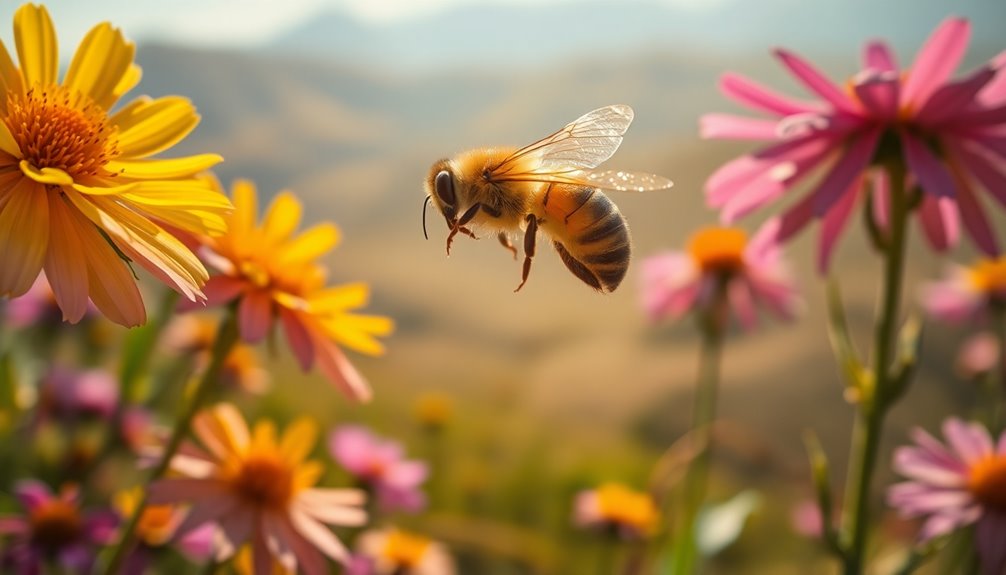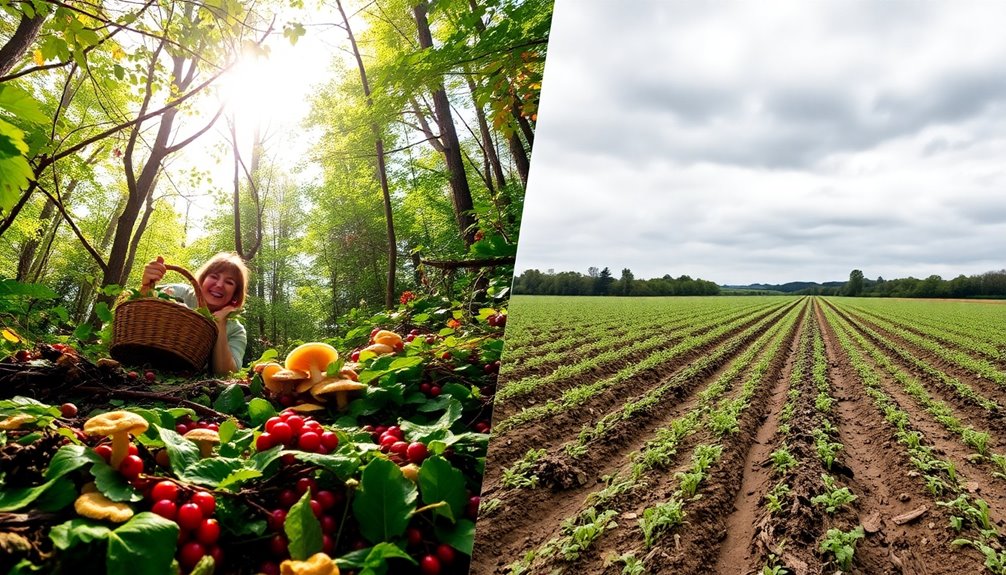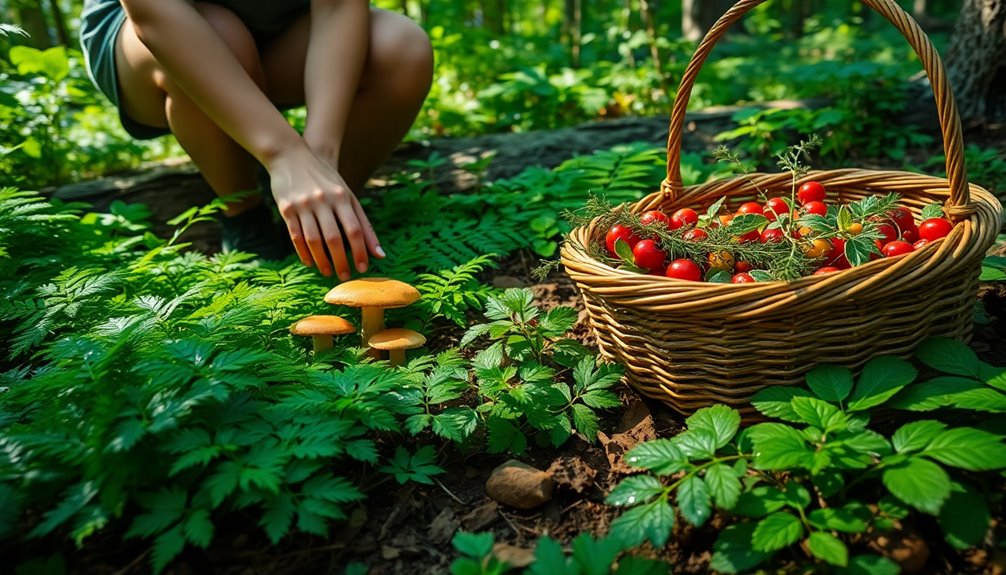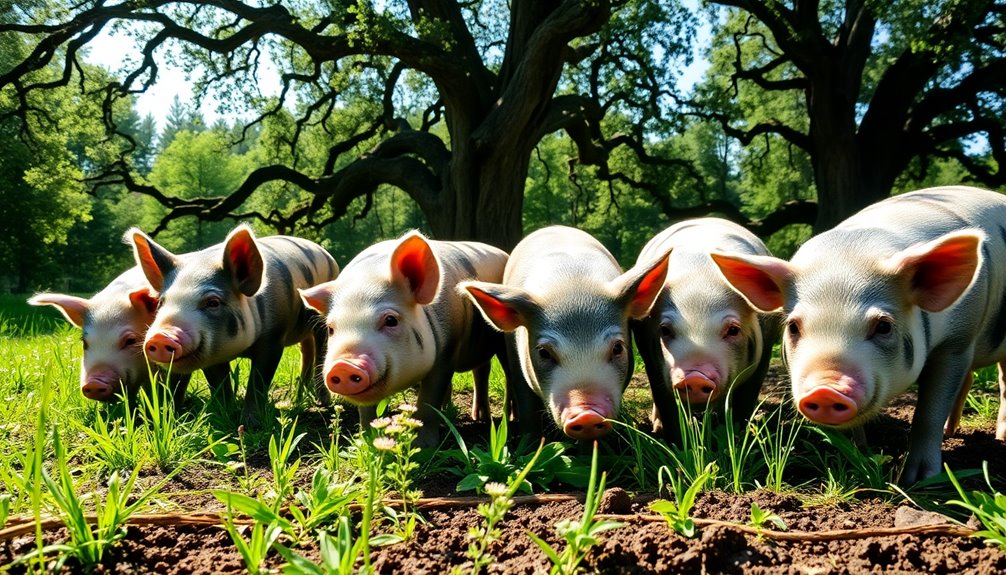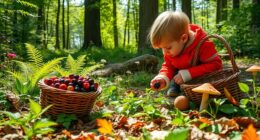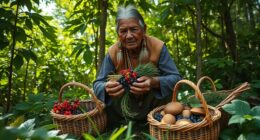Bees usually forage within 1 to 2 miles from their hive but can extend their search up to 5 miles if food is scarce. On a single outing, a bee might visit around 2,000 flowers. Factors like nectar availability and environmental conditions influence how far they travel. Scout bees play an essential role, exploring the terrain and sharing findings with the hive. Their efficiency in foraging helps maintain the colony's health and productivity. This incredible distance and teamwork make bees critical for pollination. If you're curious about their remarkable foraging methods and their impact, there's more to discover!
Key Takeaways
- Honey bees typically forage within a 1-2 mile radius from the hive but can extend to 5 miles in scarce conditions.
- A single bee can visit up to 2,000 flowers in one foraging trip, maximizing resource collection.
- Scout bees can explore up to 5 miles from the hive, enhancing foraging efficiency through communication with other bees.
- Environmental factors, like wind and temperature, significantly impact bees' foraging speed and range.
- Bees can travel 4-5 miles to find water sources, crucial for hive health and maintenance.
Foraging Distance Overview
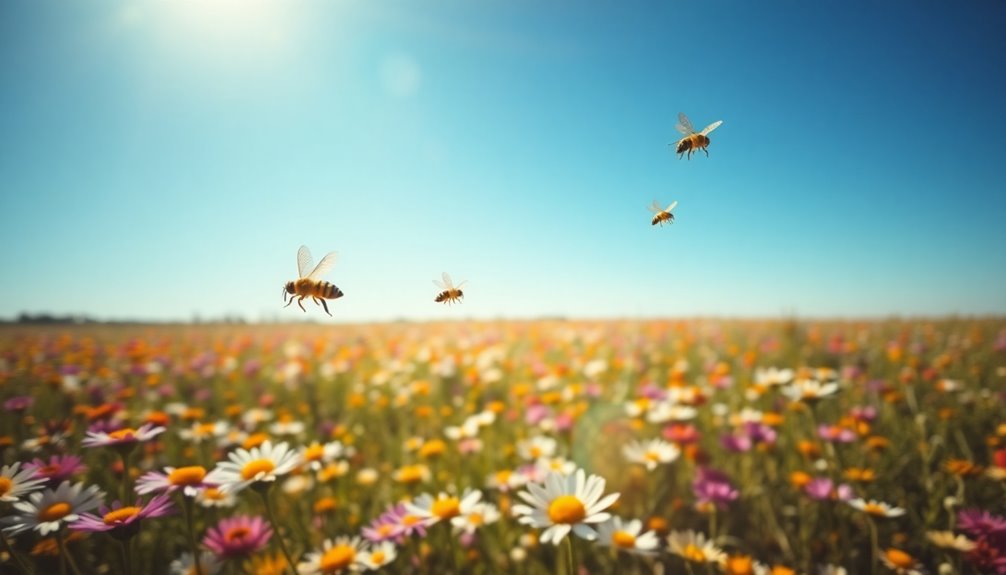
Foraging distance is essential for honey bees as they search for food and resources. Typically, these industrious bees forage within a radius of 1-2 miles from their hive. However, when food sources become scarce, they can extend their search up to 5 miles. This remarkable adaptability allows them to find critical nectar and pollen, ensuring the colony thrives.
During their foraging trips, bees can reach speeds of 15-20 mph, efficiently covering vast areas. In just one outing, a single bee might visit up to 2,000 flowers, playing a pivotal role in pollination efforts that support the ecosystem.
When you consider that a colony's foraging area can stretch across approximately 2,010 acres within a 1-mile radius, it's clear how essential these distances are for their survival.
Environmental factors, including seasonal changes and resource availability, influence bees' foraging distances and behaviors. Understanding these dynamics helps you appreciate the incredible distances these tiny creatures traverse in search of food sources.
Factors Affecting Foraging Range
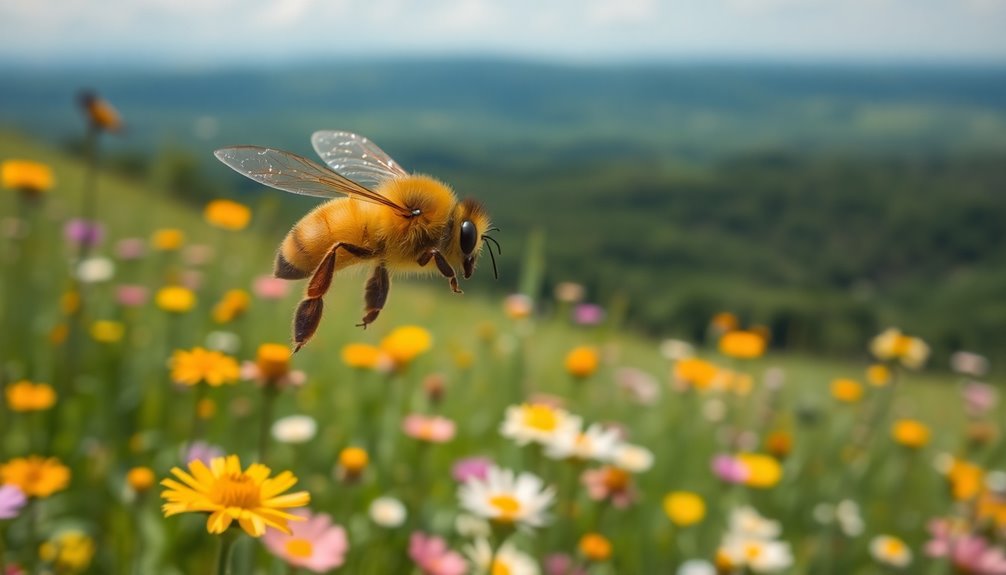
When it comes to foraging, environmental conditions and resource availability play vital roles.
You'll find that bees adjust their foraging ranges based on wind, temperature, and the abundance of nectar and pollen.
Understanding these factors can help you appreciate how bees optimize their search for food.
Environmental Conditions
Environmental conditions play an essential role in determining how far bees will venture from their hives. Factors like temperature, wind speed, and humidity directly impact their foraging range. When conditions are ideal, bees can fly longer distances in search of nectar and pollen. However, when the weather is harsh, their foraging trips may be limited.
Seasonal changes also affect bees' foraging behavior. Different seasons bring variations in the types and quantities of available food sources, which can influence how far bees are willing to travel. During times of resource scarcity, bees might extend their foraging distance up to 5 miles to find what they need.
Urbanization poses another challenge. As habitats become fragmented, bees face barriers that limit their foraging range and reduce suitable forage sites.
The health of the hive plays an equally critical role; stronger colonies with more worker bees have the capacity to venture farther in search of resources.
Resource Availability
The distance bees travel for food is largely determined by how much nectar and pollen is available in their surroundings. Under ideal conditions, you'll find bees foraging 1-2 miles from the hive in search of flowers for their bees.
However, resource availability plays a vital role; if nectar from millions of blossoms is scarce, bees may have to venture even further to meet their colony's needs.
Environmental factors, like wind and temperature, can also affect these foraging distances. A healthy hive with a larger colony can send bees farther out, while weaker hives often limit their foraging range.
Urbanization and habitat fragmentation have further complicated matters; these changes reduce local resource availability, forcing bees to travel greater distances for food.
Seasonal shifts impact the abundance and variety of flowering plants, directly influencing bee foraging behavior. When flowers bloom abundantly, bees can forage closer to home.
However, during leaner times, they may need to extend their search. Understanding these dynamics helps you appreciate the challenges bees face in sustaining their populations and the essential role they play in our ecosystems. Moreover, certain plants, such as rosemary plants, can significantly enhance local bee foraging opportunities due to their high nectar production.
Speed of Foraging Bees
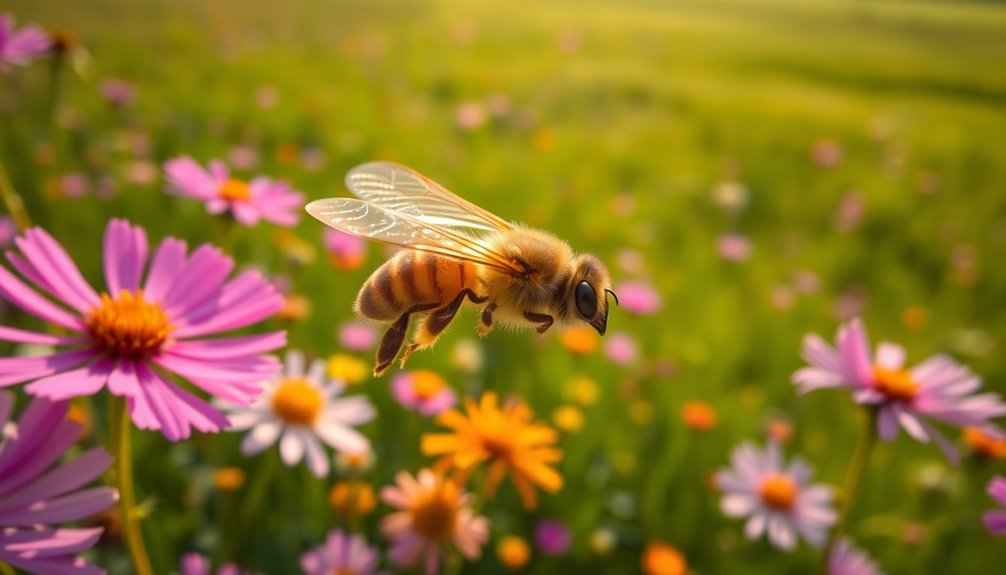
Foraging bees are remarkably swift, typically reaching speeds of 15-20 mph (21-28 km/h) while on the hunt for food.
These worker bees exhibit impressive agility, with an average flight speed of approximately 35 km/h during foraging missions. As you watch them dart among flowers, you'll notice their wings beat at about 240 cycles per second, allowing for quick maneuvers and efficient navigation through the environment.
When laden with pollen and nectar on their way back to the hive, their speed averages around 12 mph (17 km/h). This decrease in speed reflects the added weight of their precious cargo, which they collect to sustain their colony.
Environmental factors, such as wind and temperature, can also influence the speed of foraging bees, affecting how quickly they travel to and from foraging sites.
Understanding the speed of foraging bees provides insight into their efficiency and energy expenditure. Their remarkable ability to cover ground quickly allows them to maximize their foraging efforts, ensuring that the hive remains well-fed and healthy.
Next time you see them buzzing about, appreciate the incredible speed at which these tiny pollinators work!
Navigation Techniques Used by Bees

Speed alone isn't enough for bees to effectively gather food; they also rely on sophisticated navigation techniques. Honey bees use the sun's position as a compass to orient themselves and determine their flight direction throughout the day. This solar navigation helps them accurately locate and return to food sources during foraging trips.
Their sensitivity to the Earth's magnetic field further enhances their overall orientation, allowing bees to find their way back to the hive with remarkable accuracy. Additionally, bees' compound eyes are skilled at detecting polarized light, improving their navigation even in low-light or overcast conditions.
To refine their navigation, bees have three ocelli on their heads, which help them assess light changes and determine the horizon's position. This ability is vital for maintaining a proper orientation as they navigate varied landscapes.
Moreover, by adjusting their wing angles during flight, bees can maintain stable flight over different terrains, adapting their navigation strategies as needed. Together, these techniques enable bees to forage effectively and efficiently, ensuring they can gather the resources their colony needs to thrive.
Importance of Scout Bees

Scout bees play a vital role in enhancing foraging efficiency within the colony. They venture far from the hive to find the best food sources and communicate their discoveries through the waggle dance.
This unique form of communication not only informs other bees about the location but also boosts overall productivity and survival.
Role in Foraging Efficiency
In the intricate world of bees, the role of scout bees is essential for enhancing the colony's foraging efficiency. These specialized field workers venture farther than regular foragers, exploring distances of up to 5 miles to locate ideal food sources and new habitats.
While regular foragers typically stick within a 1-2 mile radius, scout bees extend the reach of the bee colony, opening up new avenues for nectar collection.
By actively searching and evaluating food availability, scout bees maximize the colony's overall foraging efficiency, ensuring that the hive can gather enough nectar and pollen to thrive. When they discover abundant resources, they return to the hive and signal this information, guiding other field workers to the best foraging sites.
This unique ability to cover greater distances not only enhances food collection but also equips the colony to adapt to changing environmental conditions.
Fundamentally, the presence of scout bees plays a pivotal role in maintaining the productivity and survival of the bee colony, making them indispensable for effective foraging and resource management.
Communication Through Dance
Successful foraging relies not only on the physical exploration by scout bees but also on their remarkable ability to communicate findings to the rest of the colony. These scout bees venture out, sometimes covering distances up to 10 km, to locate ideal food sources.
Upon returning to the hive, they perform the fascinating waggle dance, an essential form of communication that conveys both the distance and direction of these resources.
This dance doesn't just entertain; it considerably enhances the colony's foraging efficiency. Other bees watch closely, interpreting the movements of the scout bees to find the most promising locations for nectar and pollen collection.
Thanks to this sophisticated method of communication, the hive can maximize its foraging efforts, leading to better resource acquisition.
The waggle dance plays a pivotal role in ensuring the colony's success, helping it thrive in various environments. By sharing information about food sources, scout bees enable the entire colony to work together seamlessly, turning individual explorations into collective success.
Nectar and Pollen Collection
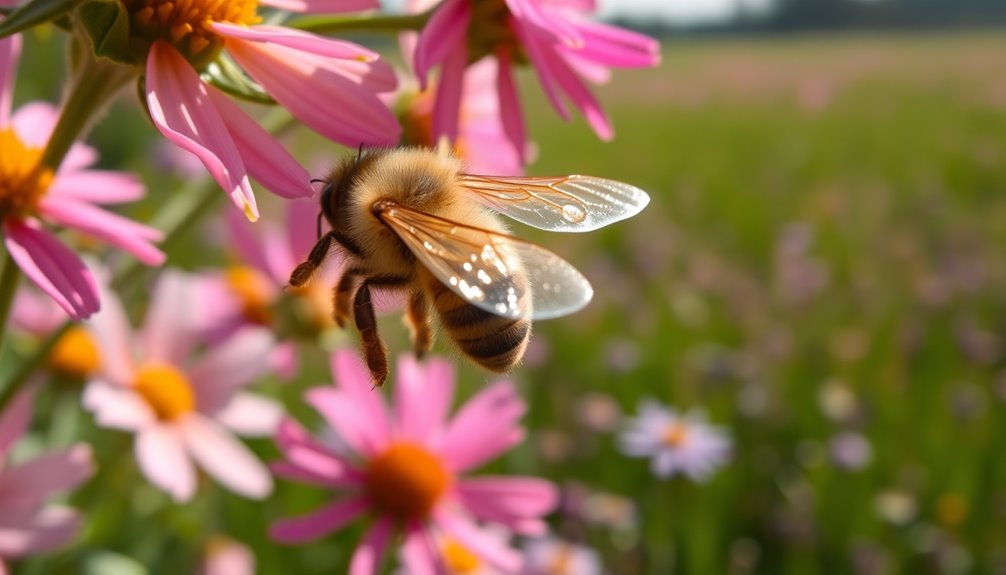
Honey bees are remarkable foragers, primarily collecting nectar from sources within 2 miles of their hive, but they can venture up to 4 miles when resources are limited. During a single foraging trip, a honey bee can visit up to 2,000 flowers, playing an essential role in pollination. This impressive foraging range allows them to gather the nectar needed for honey production, which serves as their primary energy source.
When it comes to pollen, honey bees usually stick to sources within a mile of the hive. They prioritize closer flowers to efficiently meet the colony's needs. Pollen is essential for feeding developing larvae, ensuring the hive thrives.
The distinct difference in foraging distances for nectar and pollen highlights the bees' strategy to maximize energy intake from abundant floral resources.
In your garden or nearby fields, you'll likely see these busy bees darting from flower to flower. Their diligent efforts not only sustain their colony but also support the ecosystem around you. By understanding their foraging habits, you can appreciate the significant role honey bees play in pollination and our food supply.
Water Foraging Needs
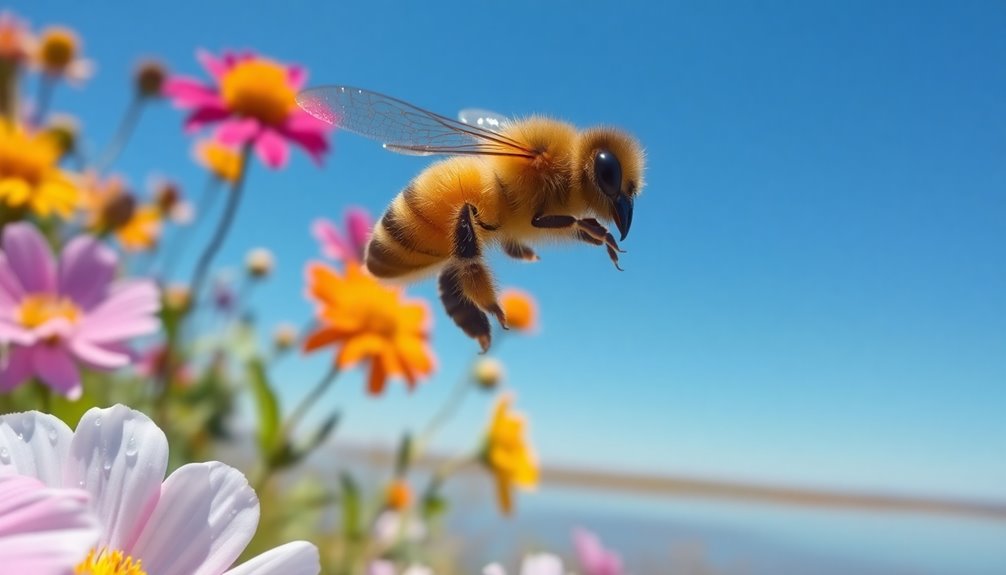
Bees are just as diligent in their search for water as they are for nectar and pollen. They can travel from their hive up to 4-5 miles to find reliable water sources, which is essential for their survival and the health of the colony. Water plays an important role in hive maintenance, helping to cool the hive, dilute crystallized honey, and keep the bees hydrated.
Here's a quick look at the foraging range and behavior of bees concerning water:
| Water Source | Distance Traveled | Importance |
|---|---|---|
| Puddles | Up to 5 miles | Hydration and cooling |
| Moist Soil | Up to 5 miles | Hive maintenance |
| Streams/Rivers | Up to 5 miles | Diluting crystallized honey |
| Birdbaths | Up to 5 miles | Accessible hydration |
Proximity to these water sources reduces energy expenditure for foraging bees, allowing them to focus more on nectar collection and other food sources. The significance of bees extends beyond honey production; they're essential for maintaining healthy ecosystems.
Impact on Ecosystem and Biodiversity
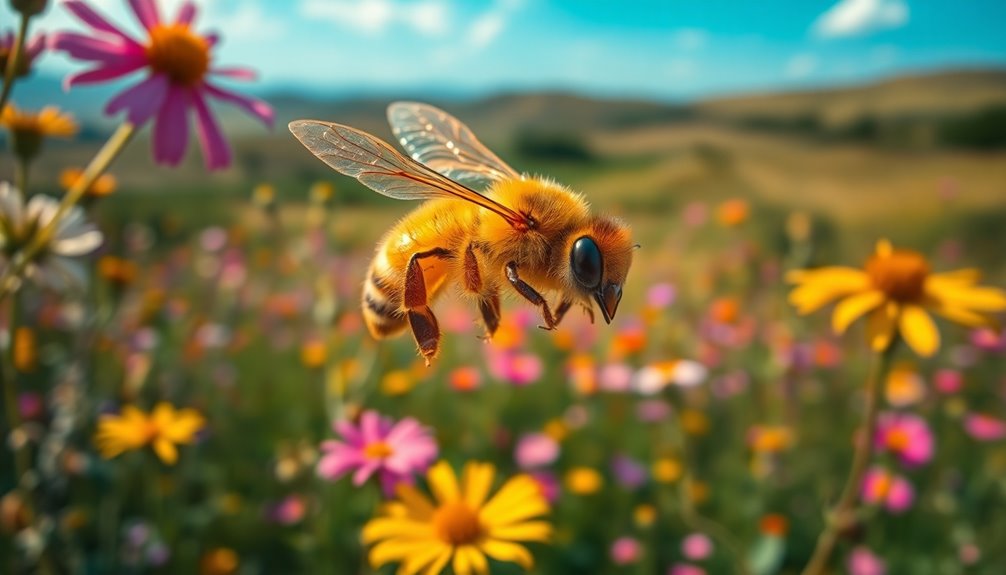
Pollination is an essential process that directly affects both food production and ecosystem health. Honey bees, as extreme pollinators, have a foraging range that can extend up to 5 miles, allowing them to pollinate around 50 million flowers in a single day. This incredible activity enhances local biodiversity, supporting the food chain and promoting the genetic diversity of plant populations.
When bees forage, they help plants reproduce, leading to healthier ecosystems that are more resilient and adaptable.
However, the decline in bee populations presents a significant threat to biodiversity. Without adequate pollination, many plants struggle to reproduce, jeopardizing the delicate balance of ecosystems. This is why habitat preservation is imperative; by safeguarding the environments where bees thrive, you help guarantee the stability and health of both natural and agricultural systems.
The loss of bees could disrupt food production and diminish the variety of plants, which ultimately impacts ecosystem health and our food supply. By recognizing the essential role bees play, you can contribute to efforts aimed at protecting these remarkable creatures and the biodiversity they support.
Global Distribution of Bees

The global distribution of bees greatly influences agricultural practices and natural ecosystems. You mightn't realize how far do bees travel to fulfill their roles as foraging bees. These tiny creatures, often seen buzzing around flowers, have been transported worldwide to enhance pollination, which is fundamental for food production.
In fact, bees typically fly several miles to find enough pollen, ensuring that crops and wild plants thrive. Bees are indispensable for pollinating approximately one-third of the human food supply, highlighting our global dependence on these industrious insects. They adapt to diverse environments, efficiently pollinating a variety of flora and contributing to local biodiversity.
This adaptability boosts ecosystems and agricultural yields, making bee populations critical for food security. However, declining bee habitats threaten this balance. As you consider the implications of dwindling bee populations, it's clear that preserving their environments is necessary for sustainable agricultural practices.
Awareness and action can foster conservation efforts, ensuring that these essential pollinators continue to support both our food systems and natural landscapes. Protecting bees isn't just about honey; it's about the future of our ecosystems and food security.
Frequently Asked Questions
How Far Do Bees Travel to Forage?
When you think about how far bees travel to forage, it's fascinating!
Typically, they venture within 1-2 miles of their hive, but if resources are low, they can extend that distance up to 5 miles.
A strong colony can pollinate millions of flowers daily, making their foraging efforts incredibly efficient.
Keep in mind, factors like weather and resource availability play a big role in determining their foraging distances.
What Is the 3 Feet 3 Mile Rule for Bees?
When it comes to bees, you can't judge a book by its cover.
The "3 feet 3 mile rule" means bees usually forage within a 1-2 mile radius from their hive, but they can travel up to 5 miles if needed.
While they can go the distance, they thrive on resources found closer to home.
This rule highlights the importance of planting nearby flowers to support your local bee population effectively.
What Is the Forage Range of a Bee?
When you think about the forage range of a bee, keep in mind they usually venture within 1-2 miles from their hive.
If resources are low, they can travel up to 5 miles. However, most bees stick to less than 1 mile for efficiency.
Scout bees help by searching further for food, ensuring the colony maximizes its foraging potential.
Factors like weather and food availability can affect how far they go, too.
What Is the 7/10 Rule in Beekeeping?
The 7/10 rule in beekeeping suggests that you should aim to plant 70% of the foraging area around your hive with bee-friendly plants.
By doing this, you're ensuring your bees have access to a diverse range of nectar and pollen sources. This variety supports their health and productivity throughout the seasons.
Plus, following this guideline not only benefits your bees but also enhances local ecosystems by promoting biodiversity in your area.
Conclusion
In the grand tapestry of nature, bees are the diligent weavers, tirelessly traveling miles to gather nectar and pollen, shaping our ecosystems. Their foraging journeys aren't just about survival; they're essential for biodiversity and food production. Understanding how far these tiny wings traverse reminds us of their significant role in our world. So, next time you see a bee buzzing by, remember it's not just a fleeting moment—it's a tiny hero on a monumental quest.

